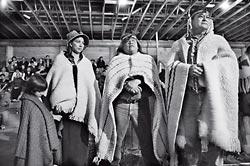T'xwelatse Comes Home

THE BURKE MUSEUM at the University of Washington threw a going-away party last fall for an ancient granite statue that had been in its collection for more than 100 years. To the timeless rhythm of drums and traditional song, aboriginal communities joined politicians from both Canada and the United States to celebrate the return of the stone sculpture to its original owners, the Sto:lo people of British Columbia.
The repatriation is part of a dramatic shift that has seen museums across the continent begin collaborating with indigenous communities to reunite them with culturally significant objects.
According to Sto:lo history, the stone holds the life force of their ancestor T'xwelatse, a man who lived in the distant past when the transformer Xa:ls was traveling through the land. T'xwelatse got into trouble for fighting with his wife, and Xa:ls turned him to stone. For generations, the stone stood outside the longhouses of his descendents, reminding them that they must learn to live together in a good way.
Then in four months in 1858, 30,000 miners flooded into British Columbia's Fraser Valley, and life for the Sto:lo was never the same. White settlers followed, and the Sto:lo were confined to reserves. The stone T'xwelatse went missing after nearly 100 settlers from Washington Territory rode into Canada in the middle of the night and lynched a 14-year-old Sto:lo boy, Louie Sam, for a crime he did not commit. The boy was from a village near the U.S. border, the same village where the stone T'xwelatse stood. Amid rumors of more violence, the village was soon deserted. Two white farmers found the stone near the village in 1892, and it was displayed in a dime store before the sons of some of Seattle's prominent pioneer families acquired it for the museum they'd founded, which eventually became the Burke.
The stone T'xwelatse was lost to the Sto:lo and might have remained so except for a Canadian social worker named Herb Joe.
As a young man, Joe had been given the traditional name of T'xwelatse. For years he sought out elders and listened to their stories about his name. Then an archeologist told Joe his ancestral namesake was in the Burke. In 1992, Joe drove to Seattle and was overcome with emotion when he saw the stone. He reported back to his "grandmothers," elders of the tribe who charged him with bringing their ancestor home.
Joe met with museum staff and told them the Sto:lo wanted T'xwelatse back. It was the opening salvo in negotiations that would ultimately last 14 long years. The biggest problem was that by U.S. law, public institutions such as the Burke can return objects only to U.S. tribes. Joe turned for help to the Nooksack, a U.S. tribe that had been divided from the Sto:lo when the border between Canada and the U.S. was drawn in 1858.
Over the years, Joe drew on the support of his extended Canadian and American families, and worked closely with archeologist Dave Schaepe, who prepared a report laden with data conclusively establishing that the stone at the Burke is the stone T'xwelatse. Staff at the Burke worked through the legal fine points of the Native American Graves Protection and Repatriation Act, and when the day of repatriation finally arrived, they were as excited and nervous as Joe and his family.
The event at the museum was only the first ceremony to celebrate the repatriation. Three days later, the stone traveled north to the Nooksack Community Centre, where some 400 people gathered to share a meal and welcome a long-lost ancestor with an honor song. Joe thanked the Nooksack Tribe, and for several hours, people stood to speak about the return. When he saw T'xwelatse, one man said, he realized he'd had a hole in his heart he didn't even know was there.
The stone spent a week in front of the tribe's Nooksack River Casino. Then, on Oct. 14, T'xwelatse traveled across the border to a Sto:lo longhouse where 500 people rose to their feet in welcome. A meal was shared, the sacred sxwo:yxwey masks were danced, and the evening ended hours later with pounding drums and joyful song.
For now, the stone is staying at the Ch-ihl-kway-uhk Tribe's headquarters in Chilliwack, B.C. T'xwelatse's final home will be an aboriginal healing and wellness center that is being built in the wilderness of the nearby Chilliwack River Valley among the same rugged mountains where the story of T'xwelatse and his transformation began so many years ago.






